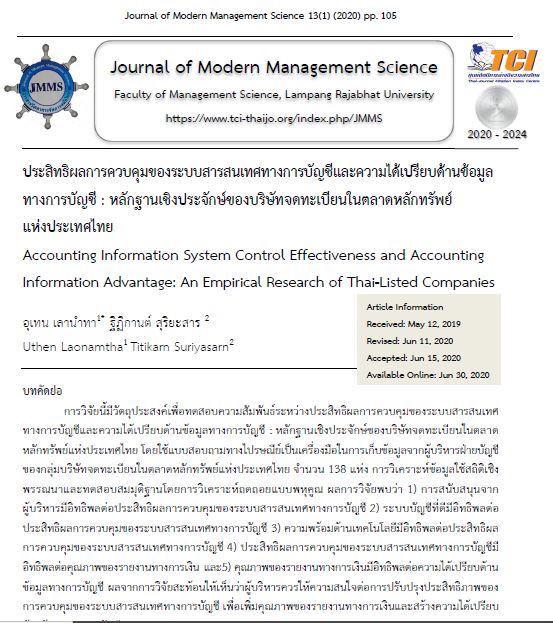ประสิทธิผลการควบคุมของระบบสารสนเทศทางการบัญชีและความได้เปรียบด้านข้อมูลทางการบัญชี : หลักฐานเชิงประจักษ์ของบริษัทจดทะเบียนในตลาดหลักทรัพย์แห่งประเทศไทย
Main Article Content
บทคัดย่อ
การวิจัยนี้มีวัตถุประสงค์เพื่อทดสอบความสัมพันธ์ระหว่างประสิทธิผลการควบคุมของระบบสารสนเทศทางการบัญชีและความได้เปรียบด้านข้อมูลทางการบัญชี : หลักฐานเชิงประจักษ์ของบริษัทจดทะเบียนในตลาดหลักทรัพย์แห่งประเทศไทย โดยใช้แบบสอบถามทางไปรษณีย์เป็นเครื่องมือในการเก็บข้อมูลจากผู้บริหารฝ่ายบัญชีของกลุ่มบริษัทจดทะเบียนในตลาดหลักทรัพย์แห่งประเทศไทย จำนวน 138 แห่ง การวิเคราะห์ข้อมูลใช้สถิติเชิงพรรณนาและทดสอบสมมุติฐานโดยการวิเคราะห์ถดถอยแบบพหุคูณ ผลการวิจัยพบว่า 1) ประสิทธิผลการควบคุมของระบบสารสนเทศทางการบัญชีมีอิทธิพลต่อคุณภาพของรายงานทางการเงิน 2) คุณภาพของรายงานทางการเงินมีอิทธิพลต่อความได้เปรียบด้านข้อมูลทางการบัญชี 3) การสนับสนุนจากผู้บริหารมีอิทธิพลต่อประสิทธิผลการควบคุมของระบบสารสนเทศทางการบัญชี 4) ระบบบัญชีที่ดีมีอิทธิพลต่อประสิทธิผลการควบคุมของระบบสารสนเทศทางการบัญชี และ 5) ความพร้อมด้านเทคโนโลยีมีอิทธิพลต่อประสิทธิผลการควบคุมของระบบสารสนเทศทางการบัญชี ผลจากการวิจัยสะท้อนให้เห็นว่าผู้บริหารควรให้ความสนใจต่อการปรับปรุงประสิทธิภาพของการควบคุมของระบบสารสนเทศทางการบัญชี เพื่อเพิ่มคุณภาพของรายงานทางการเงินและสร้างความได้เปรียบด้านข้อมูลทางการบัญชี
Article Details
บทความจะต้องผ่านการพิจารณายอมรับให้ตีพิมพ์ได้โดยกองบรรณาธิการของวารสารการจัดการ คณะวิทยาการ มหาวิทยาลัยราชภัฎลำปาง และได้รับการตรวจอ่านโดยผู้ทรงคุณวุฒิ(Peer review) และผู้เขียนบทความต้องปรับปรุงตามข้อเสนอแนะหากมีก่อนตีพิมพ์ บทความที่ไม่ผ่านการพิจารณา กองบรรณาธิการจะแจ้งให้ทราบผลการพิจารณา แต่จะไม่ส่งต้นฉบับคืนผู้เขียน
วารสารวิทยาการจัดการสมัยใหม่ คณะวิทยาการจัดการ มหาวิทยาลัยราชภัฏลำปาง ตีพิมพ์เผยแพร่ทั้งฉบับพิมพ์และฉบับออนไลน์ เราอนุญาตให้นำบทความไปใช้ประโยชน์ทางวิชาการได้ ภายใต้ขอบเขตของกฏหมายลิขสิทธิ์
เอกสารอ้างอิง
กัญฐณา ดิษฐ์แก้ว. (2558). คุณภาพของข้อมูลทางการบัญชีบริหาร นวัตกรรมทางการบริหาร การเพิ่มผลผลิตและความได้เปรียบทางการแข่งขันของผู้ประกอบการโรงสีข้าวในเขตภาคเหนือของประเทศไทย. วารสารวิทยาการจัดการสมัยใหม่, 8(1), 47-66.
กัลณี ด่านทองหลาง. (2560). ผลกระทบของระบบการควบคุมภายในต่อผลการดำเนินงานขององค์กรปกครองส่วนท้องถิ่นในจังหวัดนครราชสีมา. การศึกษาค้นคว้าอิสระของหลักสูตรบัญชีมหาบัณฑิต. มหาวิทยาลัยเทคโนโลยีราชมงคลอีสาน.
จันทร์เจ้า สุภรรุ่งเจริญ. (2554). การศึกษาระบบบัญชีและการควบคุมภายในของธุรกิจโรงพยาบาลเอกชนขนาดเกิน 100 เตียงขึ้นไปในกรุงเทพมหานคร. รายงานการวิจัยทุนส่งเสริมงานวิจัย. มหาวิทยาลัยหอการค้าไทย.
ดลฤดี ใต้เวชศาสตร์ และวิชิต อู่อ้น. (2560). ความสัมพันธ์เชิงสาเหตุของปัจจัยที่มีอิทธิพลต่อประสิทธิภาพการรายงานทางการบัญชีและผลการดำเนินงานของวิสาหกิจขนาดกลางและขนาดย่อมในประเทศไทย. RMUTT Global Business and Economics Review, 12(2), 137-158.
ธนพัฒน์ ขันกฤษณ์ และกนกศักดิ์ สุขวัฒนาสินิทธิ์. (2560). ผลกระทบของการควบคุมภายในที่มีต่อประสิทธิภาพการปฏิบัติงานของข้าราชการและพนักงานราชการกรมการเงินทหารบก. เอกสารการประชุมวิชาการและนำเสนอผลงานวิจัยระดับชาติ ครั้งที่ 7.
ธารินี เณรวงค์. (2558). ปัจจัยที่ส่งผลต่อระดับการควบคุมภายในระบบสารสนเทศทางการบัญชีภายใต้การบริหารการเงินงานคลังภาครัฐของหน่วยงานสนับสนุนภารกิจฝ่ายการเมือง. วารสารวิชาการบริหารธุรกิจ สมาคมสถาบันอุดมศึกษาเอกชนแห่งประเทศไทย (สสอท.), 4(1), 76-91.
วันวิสาข์ พวงมะลิ (2554). ปัจจัยที่ส่งผลกระทบต่อประสิทธิภาพของการควบคุมภายในตามแนวทาง COSO กรณีศึกษาการไฟฟ้าส่วนภูมิภาค เขต1 (ภาคใต้) จังหวัดเพชรบุรี. วิทยานิพนธ์หลักสูตรบัญชีมหาบัณฑิต มหาวิทยาลัยธรรมศาสตร์
ศรีรุ่งรัตน์ สุดสมบูรณ์ และชัยยศ สัมฤทธิ์สกุล. (2560). ผลกระทบของระบบบัญชีสมัยใหม่ที่มีต่อประสิทธิภาพของการบริหารองค์กร กรณีศึกษากิจการขนาดกลางและขนาดย่อมในประเทศไทย. วารสารวิทยาการจัดการสมัยใหม่, 10(2), 142-154.
สัจวัฒก์ วรโยธา, มนัสดา ชียสวนียากรณ์, วิลาสีนี แสงคำพระ และมงคล กิตติวุฒิไกร. (2561). การพัฒนาระบบบัญชีในการบริหารเพื่อเพิ่มศักยภาพในการแข่งขันของกลุ่มเย็บผ้าฝ้ายพื้นเมืองบ้านกกไอ ตำบลคำชะอี อำเภอคำชะอี จังหวัดมุกดาหาร. วารสารมหาวิทยาลัยนครพนม, 8(2), 81-89.
สุขเกษม ลางคุณเสน. (2554). การวางระบบบัญชี. ลำปาง : มหาวิทยาลัยราชภัฏลำปาง.
อุเทน เลานำทา. (2561). การออกแบบระบบบัญชี. มหาสารคาม : ตักสิลาการพิมพ์.
อุเทน เลานำทา และนิภาพร อบทอง. (2560). ความสามารถของระบบบัญชีคอมพิวเตอร์กับความได้เปรียบด้านข้อมูลทางการบัญชีของธุรกิจชิ้นส่วนอิเล็กทรอนิกส์ในประเทศไทย. วารสารการจัดการ มหาวิทยาลัย
วลัยลักษณ์, 6(3), 17-31.
Alkebsi, M. & Aziz K. A. (2017). Information Technology Usage, Top Management Support and Internal Audit Effectiveness. Asian Journal of Accounting and Governance, 8, 123-132.
Alkhaffaf, H. K., Idirs, K. M., Abdullah, A., & Aidaros, A. A. (2018). The Influence of Technology Readiness on Information Technology Competencies and Civil Conflict Environment. Indian-Pacific Journal of Accounting and Finance (IPJAF), 2(2), 51-64.
Armstrong, J. S., & Overton, T. S. (1977). Estimating Non-response Bias in Mail Surveys. Journal of Marketing Research, 14, 396-402.
Aslan, S., Diken, A., & Sendogdu, A. A. (2011). Investigation of the Effects of Strategic Leadership on Strategic Change and Innovativeness of SMEs In a Perceived Environmental Uncertainty. Procedia – Social and Behavioral Sciences, 24, 627-642.
Barney, J. (1991). Firm Resources and Sustained Competitive Advantage. Journal of Management, 17(1), 9-120.
Biswas, S. (2015). Application of Accounting Information System: A Study on Listed Banking Companies of Bangladesh. ASA University Review, 9(1), 287-298.
Boonstra, A. (2013). How do Top Management Support Strategic Information System Projects and Why do They Sometimes withhold This Support. International Journal of Project Management, 31, 498-512.
Byrd, T. A., Lewis, B. R., & Bradley, R. V. (2006). IS Infrastructure: The Influence of Senior IT Leadership and Strategic Information Systems Planning. Journal of Computer Information systems, 101-113.
Committee of Sponsoring Organizations of the Treadway Commission (COSO). (1994). Internal Control Integrated Framework. American Institute of Certified Public Accountants.
Eliijido-Ten, E. (2011). The Impact of Sustainability and Balanced Scorecard Disclosures on Market Performance: Evidence from Australia’s Top 100. Journal of Applied Management Accounting Research, 9(1), 59-74.
Fitriati, A. & Susanto, A. (2005). The Accounting Information System Quality Improvement through Internal Control and Top Management Support Effectiveness. Journal of Theoretical and Applied Information Technology. 95(19), 5003-5011.
Griffin, J. & Dempsey, S. (2009). How Influential are Accountants in the Implementation of an Integrated System? A Case Study in an Irish Public Sector Organization. Irish Accounting Review, 3(1), 31-49.
Hair, J. F., Black, B. J. & Anderson, R. E. (2010). Multivariate Data Analysis: A Global Perspective,7th ed. Upper Saddle River, NJ: Prentice Hall.
Harash, E., AI-Timimi, S., & Radhi, A. H. (2014). The Influence of Accounting Information Systems (AIS) on Performance of Small and Medium Enterprises (SMEs) In Iraq. Journal of Business & Management, 3(4), 48-57.
Hoitash, U., Hoitash, U., & Bedard J. C. (2009). Corporate Governance and Internal Control over Financial Reporting: A Comparison of Regulatory Regimes. Accounting Review, 84(3), 839-867.
Hongsombud, A., & Ussahawanitchakit, P. (2012). Accounting Quality Control and Firm Growth: An Empirical Investigation of Corporate Governance Awarded Firms in Thailand. Journal of the Academy of Business & Economics, 12(5), 97-126.
Hunton, J. E., Lippincott, B., & Reck, J. L. (2003). Enterprise Resource Planning Systems: Comparing Firm Performance of Adopters and Non-adopters. International Journal of Accounting Information Systems, 4, 165-184.
Komala, A. R. (2012). The Influence of the Accounting Manager’s Knowledge and the Top Management’s Support on the Accounting Information System and Its Impact on the Quality of Accounting Information: A Case of ZakatI in Bandung. Journal of Global Management, 4(1), 53-73.
Laonamtha, U. & Ussahawanitchakit, P. (2012). Enterprise Resource Planning System Capability and Decision Making Success: Evidence from Thai Manufacturing Businesses in Thailand. Journal of Academy of Business and Economics, 14(4), 1-15.
Laonamtha, U. & Pongpanpattana, J. (2014). The Integrated Information Systems Effectiveness in Thai Industrial Firms: An Empirical Research of Its Antecedents and Consequences. Review of Business Researc, 14(2), 103-116.
Laonamtha, U., Worawit, L., & Paikhamnam, A. (2014). Strategic Enterprise Resource Planning Management and Firm Success of Food Businesses in Thailand: An Empirical Investigation of the Antecedents and Consequences. Review of Business Research, 14(2), 89-102.
Lee, J., Elbashir, M. Z., Mahama, H., & Sutton, S. G. (2012). Enablers of Top Management Team Support for Integrated Management Control. International Journal of Accounting Information Systems, 15, 1-15.
Liu, B. (2016). Internal Control of Accounting Information System based on Network Environment. 2nd International Conference on Electronics, Network and Computer Engineering (ICENCE 2016), 905-907.
Maiga, A., Nilsson A., & Jacobs, F. A. (2014). Assessing the Interaction Effect of Cost Control Systems and Information Technology Integration on Manufacturing Plant Financial Performance. The British Accounting Review, 46, 77-90.
Nunnally, J. C. & Bernstein, I. H. (1994). Psychometric Theory. New York, NY: McGraw Hill.
Pirvut, V. (2016). Auditing of the Computerized Information Systems in the Military Organization. Scientific Bulletin, 1(41), 36-39.
Qinghe, M. & Chunxia M. (2019). Study on Enterprise Internal Accounting Control Based on Computerized Accounting. Retrieved from: http://www.seidatacollection.com/upload/product/201001/1263796804m5il314r.pdf
Ran, G., Fang, Q., Luo, S., & Chan, K. (2015). Supervisory Board Characteristics and Accounting Information Quality: Evidence from China. International Review of Economics and Finance, 37, 18-32.
Trigo, A., Belfo, F., & Estebanez, R. P. (2014). Accounting Information Systems: The Challenge of the Real-time Reporting. Procedia Technology, 16, 118-127.
Wei, W. (2015). Internal Accounting Control Based on Computerization System. Engineering Science, 7, 151-158.
Xie, Z., Ma, Z., Xie, Y., & Zhang, Y. (2017). Research on the Model of Internal Control of Computerized Accounting System Based on Network Environment. Revista de la Facultad de Ingenieria U.C.V., 32(6), 9-14.


